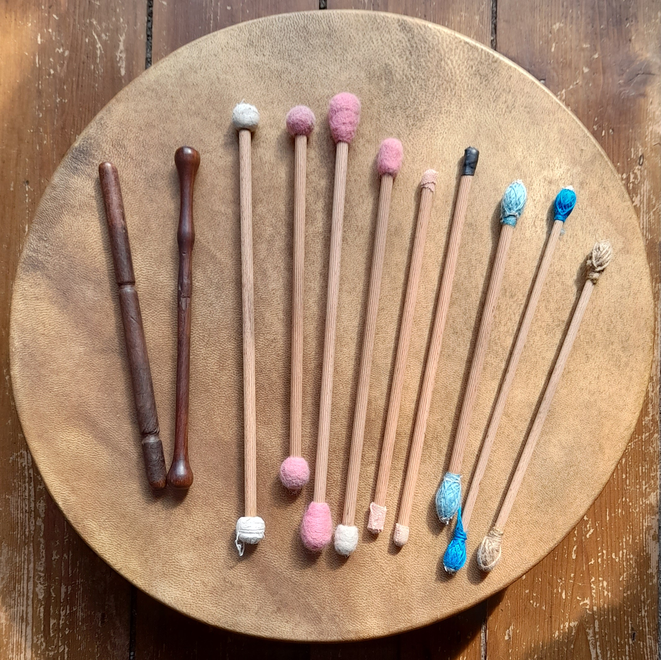Contingencies
Here I briefly discuss some important aspects of my bodhrán practice that intersect with this research, but are not considered in detail.
Drums
The bodhráns I used in this research have been with me for many years. The first was made by Charlie Byrne and purchased directly from him in 1994. He told me the skin came from a twenty-five year old puck goat. The second is a tunable double-skinned drum made by Brendan White and was bought in about the year 2000.
Sticks
This research is an exploration of bodhrán sticking practices, but the stick itself has received little consideration. In fact, the very first piece of footage recorded for this project was of me fashioning a new stick from beech dowel that I had bought at a local DIY centre. Some of the sticks that I used throughout this project are shown here on the left.
The first two sticks on the left have been with me for many years, and I can’t remember where I bought them. They are relatively heavy, being thick and made of hardwood, and well-suited to getting a good strong tone from the heavy-skinned drums I like to use, as long as the drumhead isn’t too tight. I made the other sticks over the course of this project.
Beginning this project I realised that it might be useful to try using lighter sticks. When getting lessons from Tommy Hayes in early 2021, I had learned that he favoured much lighter sticks than I would normally use, so I figured it might be something worth experimenting with. Not having a lathe to turn sticks from scratch, I decided to use ready-made wooden dowel, and find other materials with which to make the tips. I experimented with weaving different types of twine (as is done for timpani mallets), needle-felting, and also just attaching things like bandages, insulation tape and bottle corks. My current favourite stick uses fluted beech dowel with cotton balls from the art supplies shop as tips.
These lighter (and longer) sticks were a big help in developing the techniques seen in this research, allowing me to experiment with and develop novel motor movements without putting undue stress on muscles that were being exercised for the first time. I came to appreciate the sound of these lighter sticks, and the ease of movement they afforded.
Tuning
The tuning of my drums interacted in very important ways with this research in general. Because of the lighter sticks I was using, I found that I had begun to favour a much tighter drum head. All things being equal, the lighter the stick, the less volume generated. While this was often an advantage when practising at home, when playing in sessions I found that I had to work much harder to get an appropriate volume. I found that by tuning up my drum (or by not applying water slacken the skin in the case of my non-tunable Charlie Byrne drum) I could get a good volume without undue effort, and the stick also rebounded more easily, again making less work for me. As a bonus, this pushed my sound into a timbral realm that I (and most other contemporary players) have previously avoided; not somewhere I would have gone by choice, but now I enjoy exploring this space for what it is.
Tonal playing: the left hand
As a consequence of exploring different grip postures for striking the drum with my right hand during this research, the way my left hand interacted with the back of the drum also changed. These changes were mainly spatial. When playing with the orthodox Mercier grip posture, I tend to strike only certain areas of the skin, and over the years my left hand playing has developed in certain ways to accommodate this. While exploring other grip postures over the course of this research, my left hand has had to move differently to help articulate each posture effectively.
